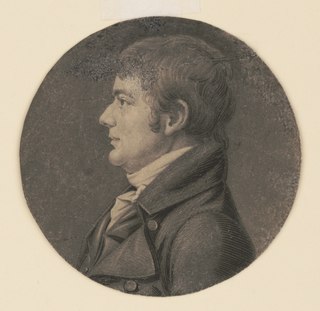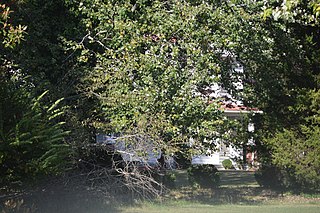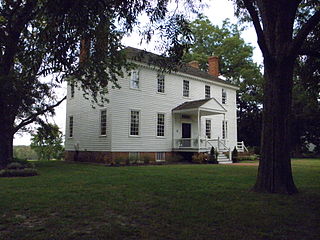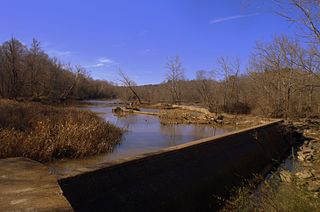
Chesterfield County is located just south of Richmond in the Commonwealth of Virginia. The county's borders are primarily defined by the James River to the north and the Appomattox River to the south. Its county seat is Chesterfield Court House.

The Appomattox Court House National Historical Park is a preserved 19th-century village in Appomattox County, Virginia. The village is the site of the Battle of Appomattox Court House, and contains the McLean House, where the surrender of the Army of Northern Virginia under Robert E. Lee to Union commander Ulysses S. Grant took place on April 9, 1865, an event widely symbolic of the end of the American Civil War. The village itself began as the community of Clover Hill, which was made the county seat of Appomattox County in the 1840s. The village of Appomattox Court House entered a stage of decline after it was bypassed by a railroad in 1854. In 1930, the United States War Department was authorized to erect a monument at the site, and in 1933 the War Department's holdings there was transferred to the National Park Service. The site was greatly enlarged in 1935, and a restoration of the McLean House was planned but was delayed by World War II. In 1949, the restored McLean House was reopened to the public. Several restored buildings, as well as a number of original 19th-century structures are situated at the site.

Poplar Forest is a plantation and retreat home in Forest, Virginia, United States, that belonged to Thomas Jefferson, Founding Father and third U.S. president. Jefferson inherited the property in 1773 and began designing and working on his retreat home in 1806. While Jefferson is the most famous individual associated with the property, it had several owners before being purchased for restoration, preservation, and exhibition in 1984.

Richard Eppes was a prominent planter in Prince George County, Virginia and a surgeon in the Confederate States Army during the American Civil War. Eppes is notable for his having kept extensive journals about his plantation and life; the journals for 1849 and 1851–1896 are held by the Virginia Historical Society and have been invaluable to historians of the Antebellum South. His Appomattox Manor was used as a base by Union general Ulysses S. Grant during his siege of Petersburg, Virginia.

Appomattox Manor is a former plantation house in Hopewell, Virginia, United States. It is best known as the Union headquarters during the Siege of Petersburg in 1864–65.

John Wayles Eppes was an American lawyer and politician. He represented Virginia in the U.S. House of Representatives from 1803 to 1811 and again from 1813 to 1815. He also served in the U.S. Senate (1817–1819). His positions in Congress occurred after he served in the Virginia House of Delegates representing Chesterfield County (1801–1803).

Shadwell is a census-designated place (CDP) in Albemarle County, Virginia. It is located by the Rivanna River near Charlottesville. The site today is marked by a Virginia Historical Marker to mark the birthplace of President Thomas Jefferson. It is listed on the National Register of Historic Places along with Clifton.

Kippax Plantation was located on the south bank of the Appomattox River in what is today the City of Hopewell in southeast Virginia. Kippax Plantation was the home of Colonel Robert Bolling (1646–1709). Bolling married Jane Rolfe, who was the granddaughter of Pocahontas and John Rolfe. Their only child, John Bolling was born at Kippax in 1676, and settled nearby at Cobbs Plantation, just west of Point of Rocks across the Appomattox River in what is now Chesterfield County. While Jane's father Thomas Rolfe (1615–1675) never lived at Kippax Plantation, it is believed that he was buried there, as were Robert and Jane.

Weston Manor is an 18th-century plantation house on the south shore of the Appomattox River in Hopewell, Virginia.

Francis Wayles Eppes was a planter and slave owner from Virginia who became a cotton planter in the Florida Territory and later civic leader in Tallahassee and surrounding Leon County, Florida. After reaching legal age and marrying, Eppes operated the Poplar Forest plantation which his grandfather President Thomas Jefferson had established in Bedford County, Virginia, which he inherited. However, in 1829 he moved with his family to near Tallahassee, Florida. Long interested in education, in 1856 Eppes donated land and money to designate a school in Tallahassee as one of the first two state-supported seminaries, now known as Florida State University. He served as president of its board of trustees for eight years.
Mary Jefferson Eppes, known as Polly in childhood and Maria as an adult, was the younger of Thomas Jefferson's two daughters with his wife who survived beyond the age of 3. She married a first cousin, John Wayles Eppes, and had three children with him. Only their son Francis W. Eppes survived childhood. Maria died months after childbirth.

Tuckahoe, also known as Tuckahoe Plantation, or Historic Tuckahoe is located in Tuckahoe, Virginia on Route 650 near Manakin Sabot, Virginia, overlapping both Goochland and Henrico counties, six miles from the town of the same name. Built in the first half of the 18th century, it is a well-preserved example of a colonial plantation house and is particularly distinctive as a colonial prodigy house. Thomas Jefferson is also recorded as having spent some of his childhood here. It was declared a National Historic Landmark in 1969.

The Clover Hill Tavern with its guest house and slave quarters are structures within the Appomattox Court House National Historical Park. They were registered in the National Park Service's database of Official Structures on October 15, 1966.
Clover Hill or Clover Hill Historic District may refer to:

In 1886, Randolph Harrison, of the Virginia department of Agriculture, cited Cumberland Mining Company, stating that the United States had purchased stock in the Brighthope Railway. He continued by citing their assertion that extending the railway into Cumberland would increase the value of farms there because they could sell consumer agricultural products such as fruit, dairy and vegetables to all markets of Virginia. The Brighthope Railway was founded in 1877 by the creditors of the Clover Hill Railroad who bought that railroad when the Clover Hill Railroad went bankrupt. The Brighthope Railway continued in the role of the Clover Hill Railroad, hauling coal from the Clover Hill Pits at Winterpock, Virginia. In addition to coal, the Bright Hope Railway transported timber and agricultural products and had passenger service. The Bright Hope Railway was narrowed from standard gauge to narrow gauge and rerouted in 1881. In 1886, much of the southern rails were changed to standard gauge. The Brighthope Railway was not changed back.

The Clover Hill Railroad was a railroad company that operated for 36 years in central Virginia near Richmond. The railroad was created to carry coal most efficiently from the Clover Hill Pits in Winterpock, Virginia, to further transportation points in Chester, Virginia, where it could be sold for a better price than on the Appomattox River in the Piedmont region. This made the railroad important to the Confederacy in the Civil War to ensure a supply of coal for munitions and iron working. The mines were dangerous for the miners, and many accidents occurred. The railroad had to be sold when coal mining declined so that new owners could find other uses for the railroad.

The Clover Hill Pits are a number of coal shafts and mines that operated in the Southside area of Richmond, Virginia, from 1837 until around 1883.

The Upper Appomattox Canal Navigation system allowed farmers who took their wheat and corn to mills on the Appomattox River, as far way as Farmville, Virginia, to ship the flour all the way to Petersburg from 1745 to 1891. The system included a navigation, modifications on the Appomattox River, a Canal around the falls Petersburg, and a turning basin in Petersburg to turn their narrow long boats around, unload the farm products from upstream and load up with manufactured goods from Petersburg. In Petersburg, workers could put goods on ships bound for the Chesapeake Bay and load goods from far away for Farmville and plantations upstream. Canal boats would return up river with manufactured goods. People who could afford it, rode in boats on the canal as the fastest and most comfortable ride. The river was used for transportation and shipping goods for over 100 years.

The Jefferson-Eppes Trophy is an American college football trophy given to the winner of irregularly played games between the Florida State Seminoles of Florida State University and the Virginia Cavaliers of the University of Virginia. The trophy was created on the suggestion of former FSU President Sandy D'Alemberte, after Virginia became the first ACC program to defeat Florida State on November 2, 1995. To that point, the Seminoles had run up a perfect 29–0 record through their first 3½ years of Atlantic Coast Conference play.























